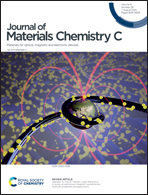Two-dimensional multiferroic FeCl with room temperature ferromagnetism and tunable magnetic anisotropy via ferroelectricity†
Abstract
Achieving multiferroic two-dimensional (2D) materials with electric field control of magnetism is highly desirable in nanospintronics, but is rare because of the mutually exclusive origins of magnetism and ferroelectricity. Based on first-principles calculations, a multiferroic metal monohalide FeCl monolayer is identified, with Fe atoms patterned in a rectangular lattice. The strong direct exchange coupling renders a high Curie temperature of 1130 K and large magnetic anisotropy energy of 1.95 meV per Fe atom, which are noticeably higher than those of a CrI3 monolayer. In particular, the parallel alignment of spin order and the electric polarization vector render the magnetic anisotropy tunable via ferroelectricity, leading to intrinsic magnetoelectric coupling. Based on the results of the phonon spectrum and Born–Oppenheimer molecular dynamic simulation, the stability of the FeCl monolayer is confirmed. Our results shed light on a new branch of 2D materials in the pursuit of magnetoelectric multiferroic materials for applications in nanospintronics.



 Please wait while we load your content...
Please wait while we load your content...